Nikon Nikkor AF-S 28-300 mm f/3.5-5.6G ED VR
3. Build quality and image stabilization
When the new Nikkor is compared to other 28-300 mm lenses, as it is done in the next chart, it would be difficult to draw any definite conclusions. The Canon is the heaviest and the biggest as its barrel is the most solid of all. The Sigma is physically the lightest but it doesn’t feature either stabilization or an ultrasonic autofocus drive. The relatively new Tamron is stabilized but it lacks “ultrasonics” so small wonder it remains smaller than the Nikkor.
In the photo below the tested lens is positioned between the Nikkor 24-70 mm f/2.8 and the Nikkor 1.8/50.
Please Support UsIf you enjoy our reviews and articles, and you want us to continue our work please, support our website by donating through PayPal. The funds are going to be used for paying our editorial team, renting servers, and equipping our testing studio; only that way we will be able to continue providing you interesting content for free. |
- - - - - - - - - - - - - - - - - - - - - - - - - - - - - - - - - - - - - - - - - - - - - - - -
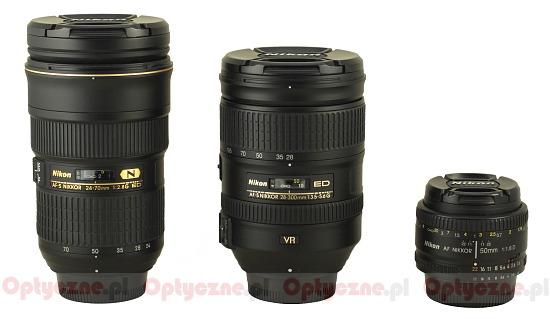 |
The Nikkor AF-S 28–300 mm f/3.5–5.6G ED VR belongs to the middle-end segment of Nikon’s lenses. It’s build quality is not as solid as e.g. that of the most expensive 24-70 mm class devices but it looks definitely better than the cheapest “kits” or zooms with plastic mounts.
The mount of the tested lens is made of metal and it surrounds a rear element with a diameter of 26 mm; it is positioned on the same level as the mount at 28 mm and it hides inside the inner tube by almost 5 cm when we pass to 300 mm focal length.
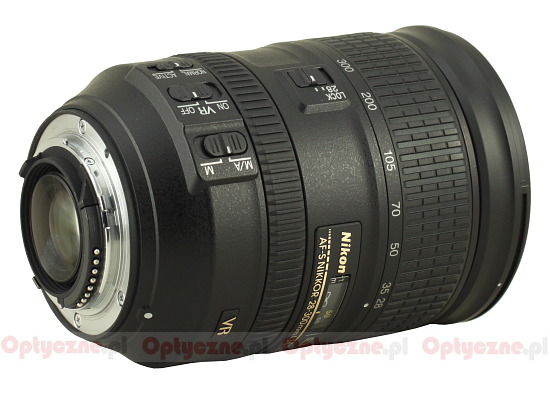 |
Behind the mount, already on the widening fragment of the barrel, we see a VR sign (it stands for Vibration Reduction), which means optical image stabilization is used. On its left you can find a row of switches. First is the M/A-M slider which allows you to choose the right focusing mechanism mode. The we have a VR ON/OFF switch which turns the stabilization on and off and behind it – a slider which enables you to choose the right stabilization working mode (Normal, Active).
 |
Further on the barrel there is a manual focus ring. It is perhaps the weakest element of the tested lens’s body. Taking into account the overall dimensions of the instrument the ring is a bit too narrow - only 11 mm wide. What’s more, it features a characteristic flaw of the cheapest Nkon’s lenses – annoying backlashes which often make precise settings impossible. Even a quite significant movement of the ring doesn’t influence the focusing at all for most of time. The ring turns, the distance scale remains immobile. Only when we move the ring in a very decisive manner the focus starts to change. Running through the whole distance scale demands circa a 150-degree turn of the ring.
Right behind the manual focus ring we can find a plate with the name and parameters of the lens; it surrounds the distance scale, expressed in meters and feet, behind a window. On the left there is also a lens blockade at 28 mm. It is sometimes useful as the lens can extend and increase its dimensions involuntarily when we point it downwards and move it slightly.
Further on we see a zoom ring. It is 3 cm wide and covered by ribbed rubber on most of its surface. Its work is not perfectly even because in the middle of the range it is more damped than at both ends. The movement of the ring makes the front element extend on a telescopic inner tube. What’s interesting the first element of that tube is made of plastics and the second – of metal. When the lens is set at 300 mm it is almost 19 cm long.
The front element is 63 mm in diameter and surrounded by a non-rotating filter thread with a diameter of 77 mm.
Inside the lens we will find 19 elements positioned in 14 groups. Two elements were made of low-dispersion ED glass and other three are aspherical. The overall image is complemented by an aperture with nine diaphragm blades which, depending on the focal length, can be closed down in the range from f/22 to f/38.
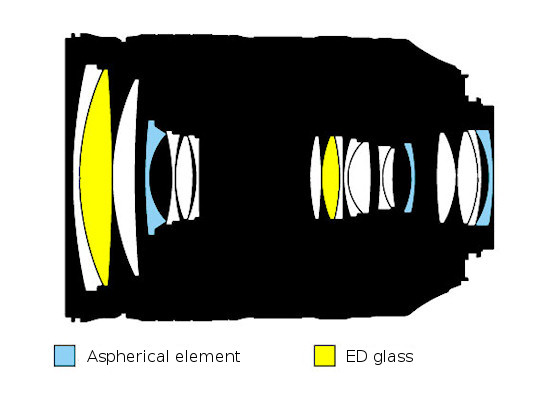 |
The buyer gets both caps, a petal-type hood and a soft case included in box.
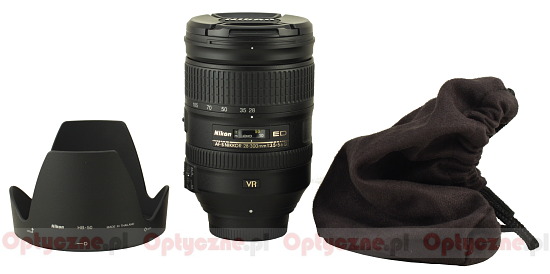 |
Stabilization
Nowadays most of manufacturers of stabilized lenses boast about a 4 EV effectiveness. Only few manage to reach the declared value, though. Let’s check whether the Nikkor is among those few.
The stabilization test was performed at 300 mm. At every exposure time ranging from 1/320 of a second to 1/8 of a second we took several dozen photos with the stabilization on and off. Then we calculated the percentage of blurred photos and we presented it as a function of the exposure time, expressed in EV. The zero point is the equivalent of the 1/250 of a second exposure time.
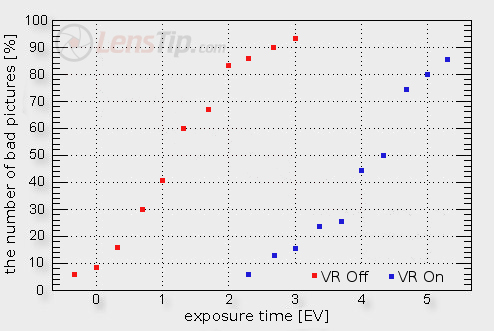
As you can notice on the graph above the maximum distance between both curves reaches a bit over 3 EV. The result is a bit short of those declared 4 EV but, on the other hand, the level of 3.2-3.3 EV should be still considered as good. There are absolutely no reasons for criticizing the Nikkor 28-300 mm VR in this category.






